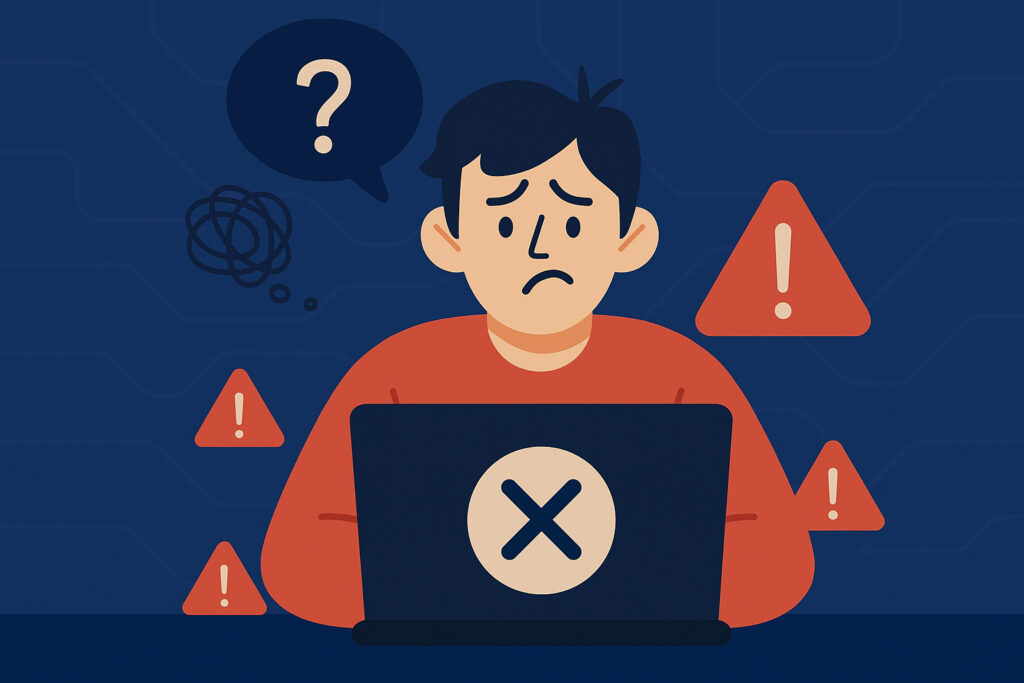If you run a website, you know that feeling in your stomach when someone tells you ”your site is down.” It’s not just about lost sales or traffic – it’s about something far more valuable and harder to rebuild: trust. When your site goes offline, even for a few minutes, you’re not just losing visitors. You’re potentially damaging relationships that took months or years to build.
Let me be straight with you: downtime is a trust killer. And in today’s digital world, trust is everything.
What Really Happens in a User’s Mind During Downtime
When someone clicks on your website and gets an error message, their brain doesn’t just shrug it off. There’s an immediate psychological response that happens in seconds.
First comes confusion. ”Did I type the URL wrong?” They’ll often try refreshing once or twice. Then comes frustration, especially if they were in the middle of something important – like checking out after filling their shopping cart or looking up your business hours before driving over.
But here’s what really matters: doubt creeps in. ”Is this business even legitimate?” ”Are they having financial problems?” ”Did they get hacked?” Your users start writing stories in their heads, and rarely are these stories positive.
I learned this the hard way years ago with a client’s e-commerce site. We had an unexpected outage during a Black Friday sale – just 47 minutes of downtime. The sales loss was bad enough, but what really hurt was the email aftermath. Customers weren’t just asking about their orders. They were asking if the company was ”still in business” and if their payment information was ”secure.” That brief downtime triggered existential questions about the entire business.
The Trust Equation: Why Every Minute Counts
Research shows that it takes multiple positive interactions to build trust, but just one negative experience can destroy it. When your site goes down, you’re essentially breaking a promise. Users expect websites to work – it’s that simple. It’s like showing up to a meeting two hours late. Even if you have a good excuse, you’ve damaged your reliability in that person’s eyes.
The psychology gets worse with each repeated incident. First downtime: ”Okay, these things happen.” Second time: ”Hmm, this is concerning.” Third time: ”I’m finding an alternative.”
And here’s something most people don’t realize – users don’t distinguish between different types of downtime. To them, it doesn’t matter if it was a server issue, a DDoS attack, or scheduled maintenance you forgot to announce. All they know is your site didn’t work when they needed it.
The Ripple Effect Nobody Talks About
Downtime doesn’t just affect the people who experience it directly. Modern users are vocal. They’ll tweet about it, mention it in reviews, or tell their friends. One person’s bad experience becomes a story that spreads.
I’ve seen businesses lose potential customers who never even visited during the downtime. They just heard about it secondhand and decided to go with a competitor instead. In the user’s mind, it becomes: ”I heard their site is always down” – even if it was down once for 20 minutes.
Social proof works both ways. Just as positive reviews build trust, negative experiences erode it exponentially when they’re shared publicly.
The Recovery Challenge: Rebuilding What’s Lost
Here’s the uncomfortable truth: rebuilding trust after downtime is harder than preventing the downtime in the first place. You need to be proactive and transparent.
If your site goes down, communicate immediately. Send an email, post on social media, put up a status page. Tell people what happened, what you’re doing about it, and when they can expect things to be back to normal. Silence makes everything worse because users fill the void with their worst assumptions.
After you’re back online, follow up. Acknowledge the inconvenience. If it affected transactions or user data, be extra transparent about what happened and what safeguards you’re implementing. Some businesses offer small compensations – a discount code or extended trial – not because they’re required to, but because it shows they value the relationship.
Prevention: The Only Real Solution
The best way to handle the psychology of downtime is to prevent it from happening. This means monitoring your site continuously, not just checking it manually once a day.
You need to know about problems before your users do. Automated monitoring checks your site every few minutes from multiple locations and alerts you instantly when something goes wrong. This gives you time to fix issues before they become trust-breaking events.
Think of it like security cameras for your business. You don’t install them after you’ve been robbed – you install them to prevent robbery in the first place.
Common Questions About Downtime and Trust
How long does it take to rebuild trust after downtime? It depends on your relationship with users and how you handle it, but expect weeks to months, not days. Consistent uptime and transparent communication are your best tools.
Do users really care about brief outages? Yes, especially if they occur during critical moments – during checkout, when accessing important information, or during peak business hours.
Is monitoring really necessary for small sites? Absolutely. Small businesses often can’t afford to lose even a single customer to downtime. Your reputation is your most valuable asset.
The Bottom Line
User trust is fragile. It’s built slowly through consistent, reliable experiences, and it can shatter in the time it takes your site to display an error message. Every minute of downtime isn’t just a technical problem – it’s a psychological event that changes how users perceive your business.
The question isn’t whether you can afford monitoring and prevention. The question is whether you can afford not to have it.
